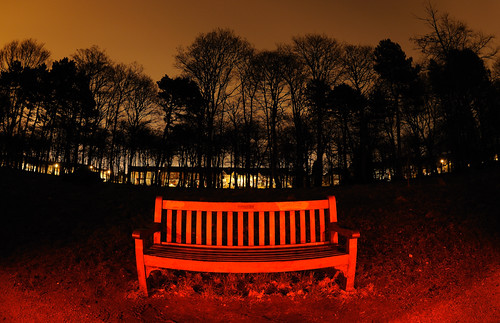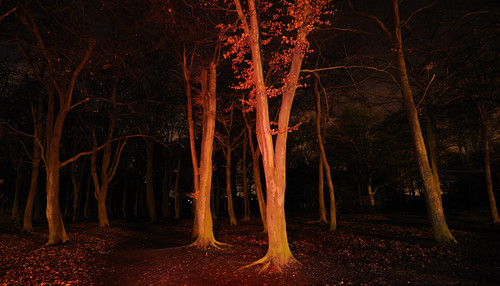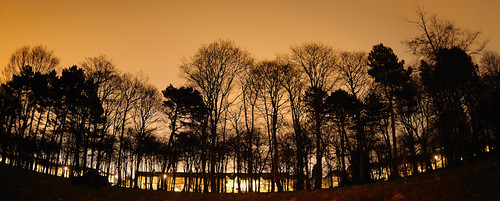What the Hell Am I Doing up at This Time? - The 4am Project
The 4am Project has just celebrated its first birthday, but this was the first time I got involved. It has been difficult to resist Karen Strunks' (The originator of the 4am Project) gentle stream of tweets over the last couple of months, so yesterday Easter Sunday (04.04) I was up at 3:30 in the morning planning to head out to take some photos. I had two plans for shooting, one was to head to Warley Woods (in Bearwood, near Birmingham, UK) with some flash guns to get some eerie shots of the canopy. The second plan was to find some empty crossroads to take some 360 degree panoramas. So with some trepidation - someone might call the police having seen strange lights in the night - I headed off to the woods.
Even though I'd tested the slave cells and flash guns at home they just didn't work well in the field (or the woods). I guess it was the distance, the use of Nikon Creative Lighting system on only one gun, and the power of the flashes. With my plan not working, well, to plan, I quickly changed what I was shooting and how. This did not stop me getting some interesting shots handholding the flash and manually firing, since the shutter was open so long (it was dark in the woods) this was very possible. The picture of Hemmingway's Bench (above) is a good example of both changing subject and technique.
I was having so much creative fun in the dark, in the woods, that I never made it to my next project idea within in the 4am Project hour. This I'll save for next time, and there will be a next time for me. This is not because I've never tried night shooting - I have many images of empty urban streets from around Europe - but because 4am Project is something different. The real genius of the 4am Project is not Karen Strunks' realisation that Birmingham was somehow different and an interesting subject to photograph at 4am, but that everyone's local environment could be different at this (befuddling) time in the morning. To get photographers around the world out of bed, looking at, and shooting they're locale (let's face it no one will want to go far at 4am) is inspired, and, no doubt, a lot of hard work.
I had this comment on one of the images I posted on Flickr:
This was one of the first 4am shots I saw this morning. My first thought was: "why have I been freezing my arse off taking crap photos when real photographers are out there taking great pics like this?!" (andytoots)
And this was my response:
Many thanks [andytoots], but I'm also an amateur who froze his arse off (there were some pros out there as well)! For me 4am Project is about the collection of all the images taken by all the nutters (and insomniacs), even the ones of the alarm clocks. It's the world at a different time and that's what makes it inspirational - well for me anyway.
That was, and is, what 4am Project is really about: an open creative photographic challenge that is building a community who are looking at their world in different ways. There are some great imaginative images in the 4am Project Flickr group and some which are just what people see, but they are all important as they form part of an archive of a time we rarely willingly see.
I learn't a few things yesterday morning, and confirmed some others, about photographing digitally at night. Below are my tips for anyone wishing to get out there for the next 4am Project.
Lastly a massive thanks to Karen for her tireless effort to make me and many other photographers get out there and take pictures when the duvet is far more welcoming!
Some brief tips for the next 4am Project outing
(Especially if you are going down to the woods!)
A tripod is often best
This is pretty essential, but it is possible to use small tripods like the Gorillapods to get interesting angles. If you don't have a tripod try making a small bean bag using lentils or rice in a cloth or strong plastic bag (The commercial version is The Pod) and this will allow you to keep your camera level and off the ground. Naturally you can up the ISO on your camera (or set it to auto) in well lit urban areas, but then you'll lose any streaks of lights from cars etc. and unless you have a Nikon D3 or D700 the images will have quite a lot of colour noise.
Have a torch (flashlight) handy
Even if you are in a well lit city centre a torch will allow you to check settings on your camera (especially on an DSLR) and if you are in a dark corner then it's essential.
Hotshoe spirit-level could be useful
Of course if you are shooting unusual angles then no need for one of these, but in the dark it is difficult to check if your camera is level (hotshoe required)
Use the self-timer or remote
Even on the tripod long exposures will suffer from blur if you press the shutter button or handle the camera. Using a self-timer also allows you to get your shadow out of shot if the lighting is coming from behind.
Charge your batteries
All of them! Long exposures, flash, bracketing exposures and shooting lots will run batteries down quickly. I had to use my back up camera battery part way through a set-up. If I didn't have the spare I would have missed my best shots.
Set focus to manual (if you can)
On autofocus the camera will spend most of it's time hunting for something to focus on. Setting it to manual will save time batteries, but this is where you need the torch with DSLRs.
Be prepared to change your plans
It's not quite the same place as it is in daylight, so the best laid plans may not be feasible at 4am. I was planning to photograph a much deeper darker part of the wood but it was too dark to see what I was shooting - perhaps I be braver next time!
Experiment!
Set yourself something new to tryout. If you're out close to home you can always try something else next time (but perhaps not the next morning at 4am). And most importantly - have fun!








